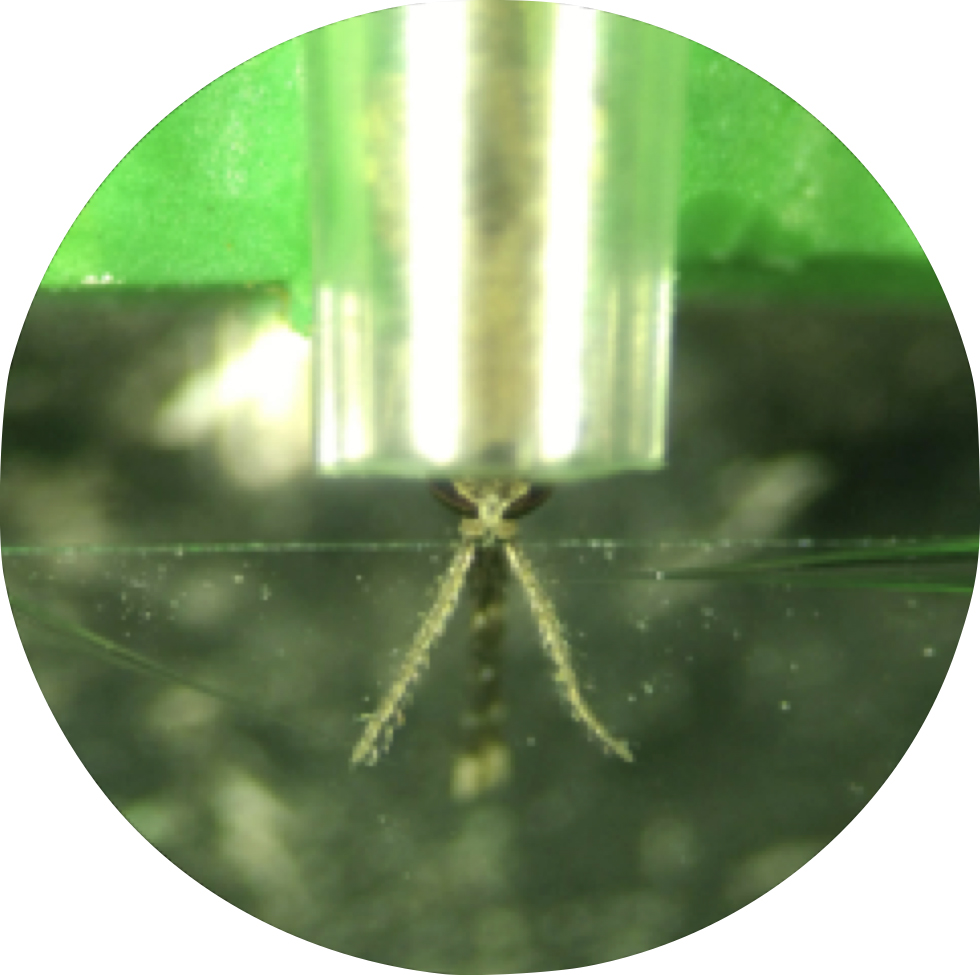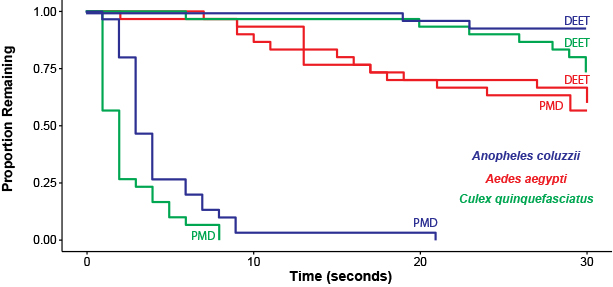Olfactory Neuron Responses and Behaviors to Spatial Repellents
A commonly used method to reduce mosquito bites is the use of odors called spatial repellents. The term ‘spatial’ indicates these repellents can function at a distance. Spatial repellents in use today (DEET, IR3535, picaridin, oil of lemon eucalyptus) were identified based on their ability to disrupt mosquito behavior. As such, the method of action for most spatial repellents remains unknown, and the biological mechanism for DEET was under debate. Our introduction of genetic methods for labeling and imaging Anopheles olfactory neurons offered an opportunity to directly address the olfactory function of repellents.
To monitor olfactory responses, we image the antennae of live female mosquitoes expressing GCaMP6f in Orco+ olfactory neurons (genotype: Orco-QF2, QUAS-GCaMP6f

IMAGE: Anopheles mosquito prepped for antennal imaging
We tested DEET, IR3535, and picaridin, and found these synthetic repellents did not activate olfactory neurons. This was surprising, as research in Aedes and Culex mosquitoes suggested DEET would activate olfactory neurons. We reasoned that under normal conditions these repellents are applied to the skin and mixed with human-odors. We mixed DEET, IR3535, and picaridin with the stimulating odorants, and then repeated the calcium imaging. In this situation, the human-derived odorants no longer stimulated olfactory neurons. We concluded that commonly used synthetic repellents function to ‘mask’ (suppress) the activity of olfactory neurons in response to host odors.
We further found that synthetic repellents reduce the volatility of other odorants (Afify, 2019). Therefore, synthetic repellents function to hide human odors from host-seeking mosquitoes. We also examined the olfactory response to natural repellents (e.g., those derived from plants such as lemongrass oil). In contrast to synthetic repellents, all natural repellents stimulated small reproducible subsets of olfactory neurons. Our analyses further suggest that different natural repellents might be activating the same olfactory neurons. This suggests a small number of olfactory neurons might be driving most odor-induced repellent behaviors.
IMAGE: Natural repellents, but not synthetic repellents, strongly activate Anopheles olfactory neurons. Example calcium imaging heatmaps showing responses at the 11th antennal segment (dashed red line) towards natural repellents lemongrass oil and eugenol and towards synthetic repellents DEET, IR3535, and picaridin. 1-octen-3-ol is a host-derived odor and is used as a positive control
Our findings that DEET did not stimulate Anopheles olfactory neurons suggested it would not function as an odor repellent. This contradicted studies in Aedes (DeGennaro, 2013) and Culex (Syed, 2008) mosquitoes. To address this confusion head-on, we established a new assay for measuring olfactory repulsion (Afify, 2019; Afify, 2020) and tested the behavioral response of Anopheles, Aedes, and Culex mosquitoes to a panel of synthetic and natural repellents (Afify, 2020). In support of our calcium imaging results, DEET odors were not repulsive to Anopheles mosquitoes. Interestingly, DEET was strongly repellent to Aedes mosquitoes, and weakly repellent to Culex mosquitoes

IMAGE: Close proximity behavioral response of mosquitoes to repellents. Thirty individual mosquitoes were tested for each odor, and the time when each jumped away from the odor was tabulated. Stronger odor repellents caused mosquitoes to jump away sooner.
This suggests that DEET likely activates odorant receptors in Aedes and Culex mosquitoes, in which it acts like a natural repellent. Confusion in the field likely arose when findings from one mosquito species were applied to all mosquito species. However, ~165 million years separates the last common ancestor of Anophelinae from Culicinae mosquitoes (Aedes+Culex) allowing ample time for the different mosquito species to evolve different olfactory responses. This highlights the need to investigate chemosensory responses in each mosquito species.


